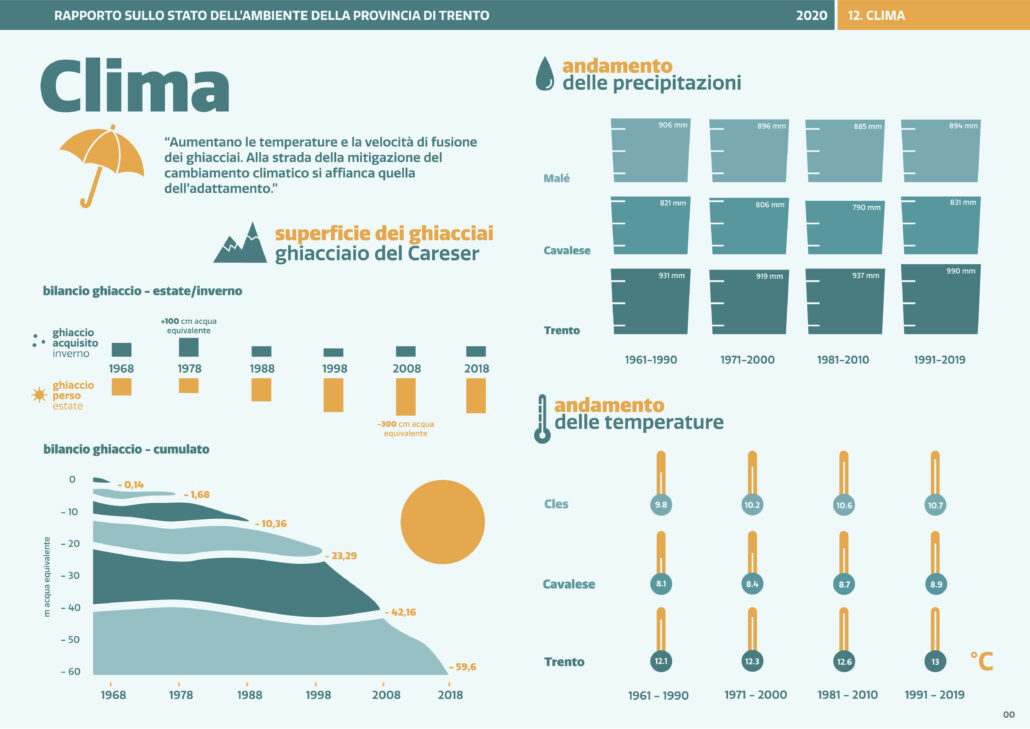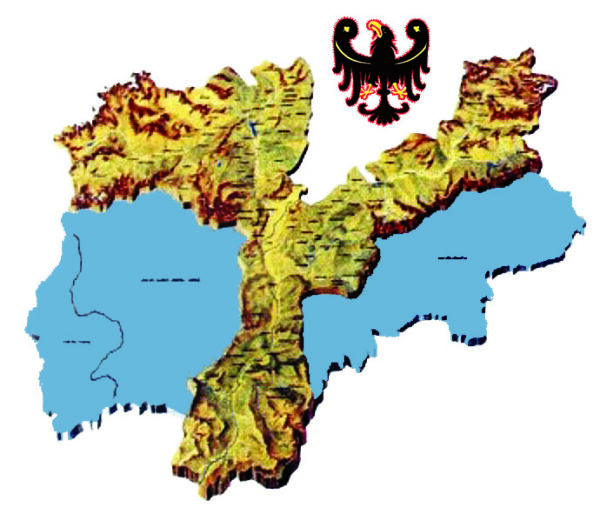December 21, 2021

The 2020 Report of the Province of Trento Environmental State-of-Art (Nono Rapporto sullo Stato dell’Ambiente) analyzed 70 environmental indicators of which 52 % were rated as medium-quality level. Compared to the previous report published in 2016, 32 % of the indicators improved their quality level while 20% of them worsened it [1]. Seemingly, Trentino believes that the environment represents an important resource that must be taken good care of. This is proven by the reduction of atmospheric emissions, the good quality level of surface and underground waters, and the moderate production of urban waste. Some indicators, however, still need improvement. Atmospheric nitrogen and ozone concentration levels have increased and so have air temperatures, thus accelerating glaciers meltdown and increasing the frequency of extreme weather events, like windstorm Vaia in 2018. The pressure added by tourism and mobility could exacerbate the whole situation.
The climate crisis has been defined by the sixth IPCC Assessment Report as a “Red Code for Humanity” [2], and Trentino is not exempted by its effects. The aim of COP 26 in Glasgow was to increase the worldwide ambition in the fight against the climate crisis in terms of mitigation (cut down carbon emissions) and adaptation (avoid and minimize the negative impacts on people, the economy and ecosystems). These would reflect on the increase of developed countries financial commitment to transit towards a more resilient and decarbonized global society.
The Paris Agreement (2015) aimed at keeping the global average temperature increase below 2 °C compared to the pre-industrial time is far from being achieved. In the hope that it could prompt a leap forward to get back on track with the Paris Agreement targets, the Glasgow Climate Pact commits signing countries to submit incisive climate action plans and strongly foster the use of renewables.
If we do not act soon, major climate changes will take the toll on our lives and in Trentino a lot is deemed to change. Studies have reported that vines will alter their phenological phases and projected a two-weeks harvest anticipation by 2050 [3]. This is supposed to happen in the provincial areas where temperatures are lower but it will dramatically change the annual results of viticulture: one of the most relevant economic sectors in Trentino. The general increase in temperatures, both annual and seasonal, the far more marked temperature increase in summer coupled with a general precipitation decrease will inevitably bring seasonal variations in the water cycle. Warmer summers with far less rain could mean more water scarcity episodes and the rise in temperature will promote glaciers depletion. In general, the Alps have suffered an increase in temperature higher than the average global value of 1.1°C (compared to 1850-1900). Being a rather fragile and vulnerable environment, they need also LOCAL countermeasures.
Trentino has taken on the challenge with the final approval of “Trentino Clima 2021-2023” Plan by the Provincial Environmental Protection Agency (Agenzia Provinciale per la Protezione dell’Abiente – APPA). Using the knowledge and advice of local scientific experts, the Plan provides the provincial administration with guidelines to contrast the ongoing climate crisis.
One of the measures taken by Trentino Clima 2021-2023, is the implementation of the Provincial Environmental Energy Plan (Piano Energetico Ambientale Provinciale – PEAP 2021-2030) by which Trentino has set out mitigation measures. Adaptation measures will be defined on a priority basis, starting from scientific evidence and vulnerability scenarios. Great importance will also be given to information and education with a particular focus on schools and youth. In this context, the Plan has established the Forum on Climate Change aimed at involving young people of Trentino in the drafting of a climate manifesto to tackle the climate crisis within the provincial territory. The Forum and the manifesto will become a starting point for fruitful collaborations with local politicians, schools and enterprises. The Forum ended with the Climate Conference of Youth in Trento and the official disclosure in November 2021, during the Meteorological Festival of Rovereto.
This case of shared governance could become the first example in Trentino of virtuous engagement between public and private bodies in dealing with the climate crisis. An issue that will inevitably have consequences on all the sectors, both public and private, and all the citizen of Trentino.

Figure 1: summary facts of the Trentino Clima 2021-23 report (source: Province of Trento press office).
Bibliography:
[1] Azienda Provinciale per la Protezione dell’Ambiente, 2020. Nono Rapporto sullo Stato dell’Ambiente della Provincia di Trento. Provincia Autonoma di Trento, APPA: 549 pp.
[2] IPCC, 2021: Summary for Policymakers. In: Climate Change 2021: The Physical Science Basis. Contribution of Working Group I to the Sixth Assessment Report of the Intergovernmental Panel on Climate Change [Masson-Delmotte, V., P. Zhai, A. Pirani, S. L. Connors, C. Péan, S. Berger, N. Caud, Y. Chen, L. Goldfarb, M. I. Gomis, M. Huang, K. Leitzell, E. Lonnoy, J.B.R. Matthews, T. K. Maycock, T. Waterfield, O. Yelekçi, R. Yu and B. Zhou (eds.)]. Cambridge University Press. In Press.
[3] Alikadic, A., Pertot, I., Eccel, E., Dolci, C., Zarbo, C., Caffarra, A., De Filippi, R., Furlanello, R., 2019. The impact of climate change on grapevine phenology and the influence of altitude: A regional study. Agricultural and Forest Metereology, 271:73-82
Cover and preview image: melting Alpine glacier. Free-source photo by Martin Adams on Unsplash
This article is part of the project “Environmental Blogging Boost 4 Students”, aimed at increasing the spread of agroecology and sustainable water management in Trentino. The project is financed by the BIM Adige Water Catchments Consortium (grant approved by provision n. 100 of June 06, 2021).




